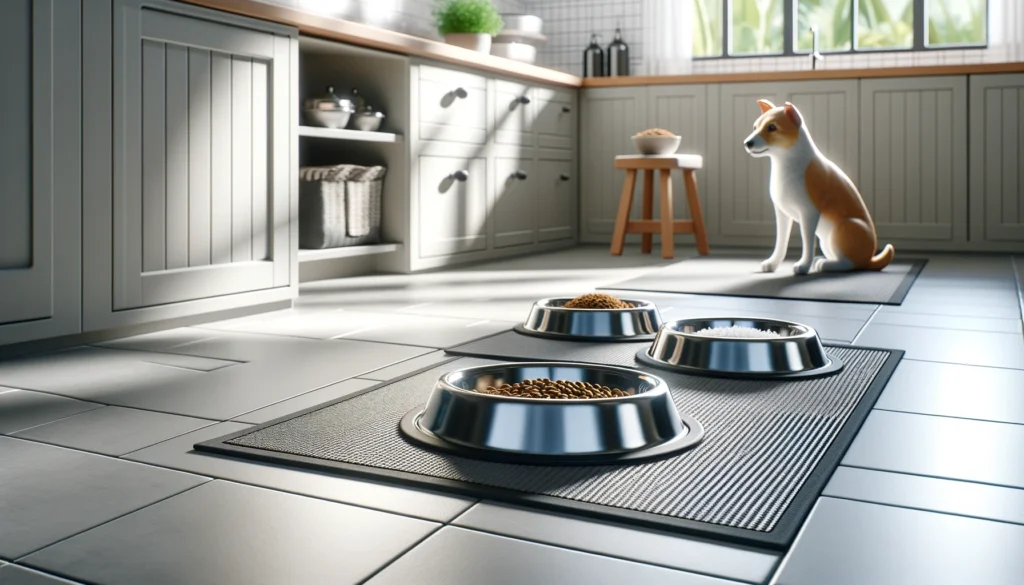Keeping your pet’s feeding area clean may not seem like a big task, but it’s one of the simplest ways to promote your pet’s overall health. Whether you have a dog, a cat, or both, daily attention to their food and water station prevents bacteria buildup, unpleasant odors, and messes across your floor.
In this guide, you’ll learn practical, everyday tips to maintain a clean and safe feeding environment — without needing any special tools or products.
Choose the Right Location
The location of your pet’s feeding area can make a big difference in how easy it is to clean and how safe it is for your pet.
- Avoid high-traffic areas: This prevents spills from being stepped on.
- Keep it away from litter boxes (for cats): Pets prefer separation between eating and bathroom spaces.
- Choose a hard surface floor: Tile or laminate is easier to clean than carpet or rugs.
If you have multiple pets, try to place their feeding stations in different spots to reduce competition or food guarding behavior.
Use the Right Bowls
Choosing the proper type of food and water bowls not only helps with cleanliness but also protects your pet’s health.
- Stainless steel or ceramic bowls are best. They’re easy to clean and don’t harbor bacteria like plastic can.
- Avoid plastic bowls, especially if they get scratched, as bacteria can settle into those grooves.
- Use non-slip bases or mats to prevent sliding and spilling.
You can also place the bowls on a feeding tray or silicone mat to catch any spills.
Wash Food Bowls Daily
Would you eat from the same unwashed plate every day? Neither should your pet. Daily cleaning is essential.
- Rinse food bowls after each meal, especially if you feed wet food.
- Wash with hot water and dish soap daily.
- Dry thoroughly before refilling to prevent bacteria growth.
If you feed dry kibble, it might not leave visible residue, but oils from the food still stick to the bowl.
Change Water Frequently
Clean water is just as important as clean food.
- Change water at least once a day — more if it gets dirty or if your pet drinks a lot.
- Wash the water bowl daily to remove any slime or buildup.
- Keep the bowl out of direct sunlight to avoid algae growth.
If your pet plays with their water or dips paws in it, check more often and clean as needed.
Clean the Floor Around the Bowls
Spills and crumbs attract insects, bacteria, and bad smells. Regular floor cleaning keeps the entire feeding zone safe.
- Sweep or vacuum the area once a day.
- Wipe down the floor with a pet-safe disinfectant weekly or more often for messy eaters.
- Use washable mats that can go in the laundry every few days.
For cats, especially, bits of food around the bowl can lead to picky eating or food refusal.
Watch for Mold and Slime
Even if you can’t see mold, it might be there. Slime, also known as biofilm, forms quickly in water bowls.
- This film is a mix of bacteria, saliva, and food residue.
- It’s common in water bowls left out for too long or not properly washed.
- Scrub all bowls thoroughly with a brush or sponge every day to remove residue.
Avoid using harsh chemicals — warm water, dish soap, and a dedicated bowl brush will do the job.
Store Food Properly
Where and how you store your pet’s food affects the cleanliness of their feeding area.
- Keep dry food in airtight containers to prevent moisture and pests.
- Store the container in a cool, dry place, away from direct sunlight.
- Do not mix old and new kibble in the same container.
- Keep food scoops clean and dry to avoid bacteria transfer.
Avoid leaving wet food out for more than 20–30 minutes to prevent spoilage.
Monitor for Allergies or Sensitivities
A clean feeding area makes it easier to notice if your pet isn’t eating or is having digestive issues. Some signs include:
- Refusing food
- Vomiting after eating
- Excessive licking around the bowl
- Sneezing near plastic bowls (possible allergy)
Keeping their area clean helps you spot these signs early and act accordingly.
Keep the Feeding Area Calm
Stress at mealtime can make some pets eat too fast or refuse to eat altogether.
- Feed your pet in a quiet, calm space.
- Avoid loud noises or distractions like TV, kids playing, or vacuuming.
- Allow your pet to eat undisturbed.
This also helps with pets that tend to guard their food when they feel anxious.
A Healthier Pet Starts with a Cleaner Bowl
Maintaining a clean and safe feeding area for your pet doesn’t take long — and the benefits are huge. From preventing illness to promoting better eating habits, this small daily routine has a big impact.
It’s about more than just cleanliness — it’s an act of care and love. And your pet will feel it in every fresh bowl of food and sip of clean water.






